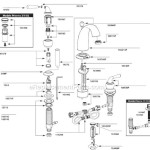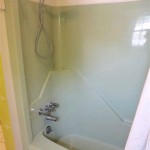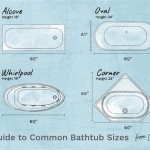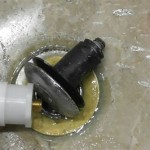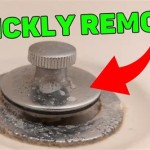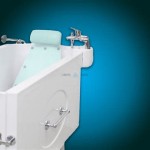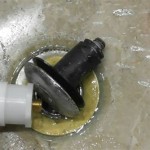How to Clean a Bathtub Drain
A clogged bathtub drain is a common household problem, often resulting in standing water during showers or baths and slow drainage thereafter. This issue is primarily caused by the accumulation of hair, soap scum, mineral deposits, and other debris within the drainpipe. Regular cleaning of the bathtub drain is essential to prevent significant clogs, maintain proper drainage, and avoid costly plumbing repairs. This article outlines various methods for effectively cleaning a bathtub drain, ranging from simple, readily available solutions to more involved techniques.
Identifying the Cause of the Clog
Before initiating any cleaning method, it is crucial to understand the potential cause of the clog. The most frequent culprit is hair, which tends to bind with soap scum and other sticky substances to form a solid mass within the drainpipe. Other common contributors include shampoo residue, conditioner, dead skin cells, and bath oils. Mineral buildup from hard water can also gradually restrict the flow of water through the drain. Inspecting the drain cover or stopper can often provide visual clues about the nature of the blockage. Removing any visible debris from the drain opening is usually the first step in addressing a clogged bathtub drain.
If the water is draining slowly but not completely stopped, the clog is likely partial. A partially blocked drain may respond well to simpler cleaning methods. However, if the water is standing and not draining at all, the clog is likely severe and may require more aggressive approaches. Understanding the severity and potential causes of the clog contributes to selecting the most appropriate cleaning method.
Simple Solutions: Hot Water and Baking Soda & Vinegar
For minor clogs or as a preventative measure, pouring boiling water down the drain can often be effective. The hot water helps to dissolve soap scum and loosen minor debris. It is important to exercise caution when using boiling water, especially in older plumbing systems or with PVC pipes, as extreme heat can potentially damage these materials. Run hot tap water for a few minutes prior to using boiling water to warm up the pipes and reduce the risk of thermal shock.
A baking soda and vinegar solution is another readily available and relatively gentle method for cleaning bathtub drains. This method involves first pouring one cup of baking soda down the drain, followed by one cup of white vinegar. The combination of baking soda and vinegar creates a chemical reaction that produces fizzing and bubbling. This fizzing action helps to loosen and break down the clog. Allow the mixture to sit in the drain for at least 30 minutes, or preferably overnight for more stubborn clogs. After the waiting period, flush the drain with hot water to clear away the loosened debris. This process can be repeated if necessary.
The reaction between baking soda and vinegar produces carbon dioxide, which is a relatively weak acid and base reaction. While it's generally safe for pipes, avoid using this method excessively, as repeated applications could potentially corrode older metal pipes over time. Always exercise caution when using chemical cleaners or alternatives.
Manual Removal Methods: Plungers and Drain Snakes
A plunger is a standard tool for clearing clogged drains. It works by creating suction and pressure to dislodge the blockage. To use a plunger effectively, ensure that there is enough water in the bathtub to cover the cup of the plunger. Create a tight seal around the drain opening with the plunger and then vigorously plunge up and down for several minutes. Periodically lift the plunger to check if the water drains. Repeat the process until the clog is cleared. A flange plunger (toilet plunger), with its fold-out soft rubber flap, is generally more effective for bathtub drains than a standard cup plunger. Ensure any overflow drain openings are sealed shut with a damp cloth or duct tape to maintain suction.
A drain snake, also known as a plumbing snake or auger, is a flexible tool that can be inserted into the drainpipe to physically break up or retrieve the clog. Drain snakes come in various lengths and designs, ranging from simple manual models to motorized versions. To use a drain snake, carefully insert the tip of the snake into the drain opening and feed it down the pipe. Rotate the handle of the snake to advance it through the drainpipe, applying gentle pressure to break up or snag the clog. Once resistance is felt, continue rotating the snake to further break down the blockage or to wrap it around the debris. Slowly retract the snake, pulling out any debris that has been dislodged. Repeat the process until no more debris is retrieved and the water drains freely. Wear gloves when handing a drain snake and cleaning the collected debris from the snake.
Drain snakes can be effective for removing stubborn clogs that are located deeper within the drainpipe. However, it is important to use caution when using a drain snake, as excessive force can potentially damage the drainpipe, especially in older plumbing systems. In some cases, the drain snake may push the blockage further down the drain, making it more difficult to access and remove. A flexible grabber tool can also be useful for retrieving hair and debris from the drain opening.
Chemical Drain Cleaners: Use with Caution
Chemical drain cleaners are commercially available products designed to dissolve or break down clogs. While these products can be effective in some cases, they should be used with caution due to their corrosive nature and potential environmental impact. Chemical drain cleaners typically contain strong chemicals, such as sodium hydroxide (lye) or sulfuric acid, which can damage pipes, especially if used repeatedly or improperly. Always follow the manufacturer's instructions carefully when using chemical drain cleaners, and wear appropriate protective gear, such as gloves and eye protection.
Before using a chemical drain cleaner, attempt the other methods described previously. Chemical drain cleaners should be considered a last resort for stubborn clogs that do not respond to other treatments. Avoid mixing different types of chemical drain cleaners, as this can create dangerous fumes and potentially explosive reactions. If the chemical drain cleaner does not clear the clog after the recommended time, do not use it again. Instead, consult a professional plumber.
The corrosive nature of chemical drain cleaners can damage pipes and fixtures, particularly older plumbing systems made of cast iron or PVC. These chemicals can also harm the environment if they are not disposed of properly. Consider eco-friendly alternatives, such as enzyme-based drain cleaners, which use natural enzymes to break down organic matter without harming pipes or the environment. Enzyme-based cleaners may be less aggressive than chemical cleaners but are still effective for maintaining drain health and preventing clogs.
Removing the Bathtub Drain Stopper
Many bathtub clogs occur directly beneath the drain stopper. Removing the stopper allows for direct access to this area and simplifies the removal of accumulated hair and debris. The method for removing the stopper varies depending on the type of stopper mechanism installed in the bathtub. Common types of stoppers include lift-and-turn stoppers, pop-up stoppers, toe-touch stoppers, and trip-lever stoppers. Consult the manufacturer's instructions or online resources for specific instructions on how to remove the stopper from the particular bathtub drain.
Lift-and-turn stoppers typically have a screw or knob that can be loosened to release the stopper. Pop-up stoppers often have a linkage mechanism that can be accessed after removing the stopper cover. Toe-touch stoppers can usually be unscrewed or pried off. Trip-lever stoppers, which are connected to a lever on the overflow plate, require removing the overflow plate and disconnecting the linkage to release the stopper. Once the stopper is removed, use a flashlight to inspect the drain opening and remove any visible hair or debris with a bent wire, tweezers, or a small hook. Rinse the stopper and drain opening thoroughly before reassembling the stopper mechanism.
Cleaning the area beneath the drain stopper is an effective way to prevent future clogs. Regularly removing accumulated hair and debris from this area helps maintain proper drainage and reduces the need for more aggressive cleaning methods. Consider using a drain strainer or hair catcher to prevent hair and other debris from entering the drainpipe in the first place.
Preventative Measures: Maintaining a Clean Drain
Preventing clogs is easier and more cost-effective than clearing them. Several preventative measures can be taken to maintain a clean bathtub drain and avoid future blockages. Regularly flush the drain with hot water after each use to help dissolve soap scum and prevent it from accumulating. Install a drain strainer or hair catcher over the drain opening to trap hair and other debris before they enter the drainpipe. Clean the drain strainer regularly to prevent it from becoming clogged itself.
Avoid pouring oil, grease, or food scraps down the drain, as these substances can solidify and contribute to clogs. Periodically flush the drain with a baking soda and vinegar solution or an enzyme-based drain cleaner to maintain drain health and prevent the buildup of organic matter. Consider scheduling regular drain cleaning as part of a routine household maintenance program.
Educate all household members about proper drain care practices. Encourage them to avoid letting hair or other debris enter the drain and to report any signs of slow drainage promptly. By implementing these preventative measures, the frequency of bathtub drain clogs can be significantly reduced, and the lifespan of the plumbing system can be extended.

How To Unclog A Shower Drain Without Chemicals Diy Family Handyman

4 Ways To Clean A Bathtub Drain Wikihow

Top 5 Tips On How To Unclog A Bathtub Drain Smiley Cleaning

4 Ways To Clean A Bathtub Drain Wikihow

How To Unclog A Bathtub Drain Homeserve Usa

How To Unclog A Bathtub Drain Without Chemicals

How To Unclog A Shower Drain Without Chemicals Diy Family Handyman

How To Easily Unclog Bathtub Shower Drain In 5 Minutes Jonny Diy

3 Simple Ways To Unclog A Bathtub Drain Naturally Wikihow

3 Simple Ways To Unclog A Bathtub Drain Naturally Wikihow
Related Posts

